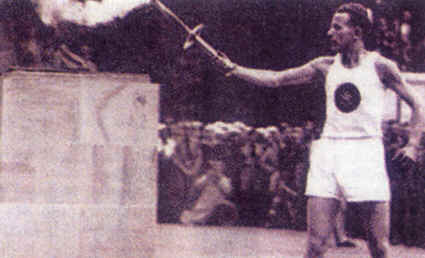 |
The 1936 Berlin Olympic Games had been handed to Berlin before the Nazis came to power but now it was the perfect opportunity for Hitler to demonstrate to the world, how efficient the Nazi Germany was. It was also the perfect opportunity for the Nazis to prove to the world the reality of the Master Race. The Berlin Olympic Games gave the Nazis an opportunity to show off to the world as 49 countries were competing bringing with them their assorted media. For Propaganda Minister Joseph Goebbels, it was the perfect scenario.
The Nazi Germany team had been allowed to train fulltime thus pushing to the limit the idea of amateur competition. Germany’s athletic superstar of the time was Lutz Lang – a brilliant long jumper who easily fitted into the image of blond hair, blue eyed Aryan racial superiority. By far the most famous athlete in the world was Jesse Owens of America – an African American and therefore, under Nazi ideology, inferior to the athletes in the German team.
The vast Olympic stadium was completed on time and held 100,000 spectators. 150 other new Olympic buildings were completed on time for the event. The anti-Semitic posters that had littered Germany before the games had disappeared. Signs that stated “Jews not welcome here” were not longer visible – anything was done to ensure that the Games went smoothly and caused no upset.
In fact, the upset was caused in the stadium itself. The ‘racially inferior’ Owens won four gold medals; in the 100m, 200m, long jump and 4 x 100m relay. During the Games he broke 11 Olympic records and defeated Lutz Lang in a very close long jump final. Lang was the first to congratulate Owens when the long jump final was over. There were 10 African American members of the American athletics team. Between them they won 7 gold medals, 3 silvers and 3 bronze – more than any national team won in track and field at the Games, except America itself. Hitler refused to place the gold medal around Owen’s neck.
The one area where the Nazis seemed to excel was in the use of radio for the reporters. Twenty transmitting vans were put at the disposal of the foreign media along with 300 microphones. Radio broadcasts at the Olympics were given in 28 different languages. A director of NBC in America congratulated the Nazis for this service – a personal triumph for Joseph Goebbels as he was in charge of this aspect of the Olympics.
Siegfried Eifrig helped to carry the torch that lit the flame at the 1936 Berlin Olympics. To the Nazi regime he personified the Aryan race – tall, blond, blue-eyed and athletic. At the age of 26, Eifrig took the torch at the beginning of Unter den Linden – Berlin’s main boulevard – before handing it over so that others could carry it to the Olympic stadium. Though he was a talented sprinter, Eifrig did not get into the German Olympic squad. But he ran with distinction for the Charlottenburg Athletic Club and as a result was given the opportunity to carry the Olympic torch into the stadium.
“It was an enormous honour to carry the torch, of course it was. I wasn’t so much nervous as really concentrating. I had to make sure nothing went wrong. There were so many people there. People said there were 300,000 people watching me on my stretch.”
Eifrig fought in North Africa and ended the war in a British POW camp.
“The Americans should be ashamed of themselves, letting Negroes win their medals for them. I shall not shake hands with this Negro…….do you really think that I will allow myself to be photographed shaking hands with a Negro?”
Balder von Shirach claimed Hitler said this after the 100m victory of Jesse Owens.